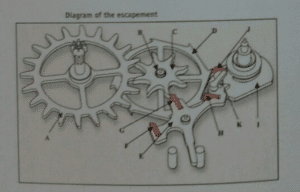“The coaxial escapement is the first practical new watch escapement in the 250 years following the invention of the lever escapement by Thomas Mudge in the 18th century. It fulfills all the requirements of a precision watch escapement with the advantage of robust reliability and close precision rate for long term performance. In its present form the coaxial represents the culmination of 20 years of development. It is intended to sustain the public affection for the mechanical watch during the 21st century.”
George Daniels, Master Watchmaker
In simple terms, the escapement is the heart of the mechanical watch, as it generates the impulses that make the mechanism move. The new OMEGA coaxial escapement drastically reduces the friction among the parts that transmit energy to the other components. The result is reduced servicing requirements for the movement and, above all, greater stabillity of the watch’s precision over time.
The new OMEGA calibres with coaxial escapement, refined by the introduction of OMEGA’s free sprung-balance for maximum precision, represent one of the greatest revolutions in the history of master watchmaking. This innovation from OMEGA sets new standards in reliability for mechanical watches.
The energy to maintain the free sprung-balance is transmitted by an escapement whose energy transmission is obtained by the tangential motions of the parts.
The escapement is composed of an intermediary wheel A, a double coaxial wheel B composed of escapement pinion C and escapement wheel D, pallets E with 3 ruby pallet-stones F, G, H and a roller I carrying a ruby impulse stone J and a ruby impulse pin K.
The roller is fitted to the sprung balance.
It is essential that a successful escapement for use in a modern watch must transmit energy to the oscillator in both clockwise and anti-clockwise vibrations. In the coaxial escapement, the clockwise impulse is delivered to the oscillator directly by the escape wheel engaging the balance roller. The anti-clockwise impulse is delivered to the balance roller via the lever. After each impulse, the escape wheel is locked stationary by the lever locking pallets allowing the balance to complete its vibration undisturbed.

The OMEGA free sprung-balance
The OMEGA regulating system is comprised of an oscillating sprung-balance without index. It is composed of a balance with a variable moment of inertia and a flat balance-spring.
The moment of inertia is adjusted using 2 gold regulating micro screws B and B₁. The balance-spring C is an Anachron thermo-compensating alloy with a terminal curve stabilised against shocks. The collet D is of the type Nivatronic and poised.
Advantages of the coaxial escapement
The coaxial escapement reduces the friction between the escape wheel and the pallets to practically zero. The ingenious principle behind the escapement solves the problem of lubrication – one of the biggest problems encountered with the mechanical movement – by making it almost superfluous. This brings two crucial benefits for the movement: a longer lifetime and, above all, long-term accuracy. The coaxial escapement thus guarantees constant transmission of energy to the sprung-balance over time.
Advantages of the OMEGA free sprung-balance system
The regulating system used on the coaxial escapement is a sprung-balance without index (the latter being a common source of precision performance problems). The regulating stability is therefore improved and guaranteed over time. The systems’s greater resistance to shocks further contributes to this chronometer’s accuracy.
Combined advantages of the coaxial escapement and the OMEGA free sprung-balance
The combined advantages of the two elements make the new OMEGA calibres equipped with the coaxial escapement high precision chronometers with high stability of accuracy over long periods of use. As a result, service intervals increase to several years.






